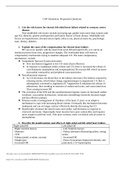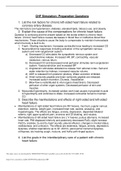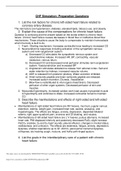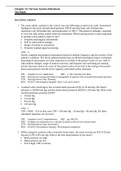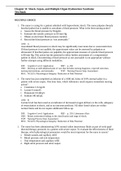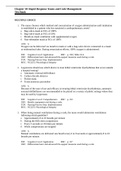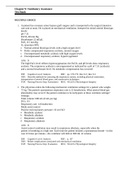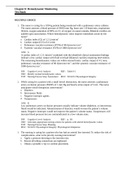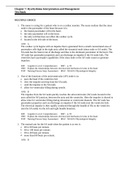Minnesota School Of Business
Latest uploads at Minnesota School Of Business. Looking for notes at Minnesota School Of Business? We have lots of notes, study guides and study notes available for your school.
-
59
- 0
-
4
All courses for Minnesota School Of Business
Latest notes & summaries Minnesota School Of Business
NURSING 302 CHF Simulation: Preparation Questions. 1. List the risk factors for chronic left-sided heart failure related to coronary artery disease. Non-modifiable risk factors include increasing age, gender (men more than women until age 65), ethnicity, genetic predisposition and family history of heart disease. Modifiable risk factors are hypertension, elevated serum lipids, tobacco use, physical inactivity, psychologic state, obesity, diabetes. 2. Explain the cause of the compensations...
NURSING 302 CHF Simulation: Preparation Questions. 1. List the risk factors for chronic left-sided heart failure related to coronary artery disease. The risk factors are hypertension, diabetes, elevated lipids, tobacco use, and obesity. 2. Explain the cause of the compensations for chronic heart failure. Question is confusing and the answer based on the words written is chronic heart failure. Chronic heart failure causes decreases in blood flow or ineffective blood flow mechanisms. These s...
NURSING 302 CHF Simulation: Preparation Questions 2022. 1. List the risk factors for chronic left-sided heart failure related to coronary artery disease. The risk factors are hypertension, diabetes, elevated lipids, tobacco use, and obesity. 2. Explain the cause of the compensations for chronic heart failure. Question is confusing and the answer based on the words written is chronic heart failure. Chronic heart failure causes decreases in blood flow or ineffective blood flow mechanisms. Th...
1. The nurse admits a patient to the critical care unit following a motorcycle crash. Assessment findings by the nurse include blood pressure 100/50 mm Hg, heart rate 58 beats/min, respiratory rate 30 breaths/min, and temperature of 100.5°. The patient is lethargic, responds to voice but falls asleep readily when not stimulated. Which nursing action is most important to include in this patient’s plan of care? a. Frequent neurological assessments b. Side to side position changes c. Rang...
1. The patient is admitted with a suspected acute myocardial infarction (MI). In assessing the 12- lead electrocardiogram (ECG) changes, which findings would indicate to the nurse that the patient is in the process of an evolving Q wave myocardial infarction(MI)? a. ST-segment elevation on ECG and elevated CPK-MB or troponin levels b. Depressed ST-segment on ECG and elevated total CPK c. Depressed ST-segment on ECG and normal cardiac enzymes d. Q wave on ECG with normal enzymes and troponi...
1. The nurse is caring for a patient admitted with hypovolemic shock. The nurse palpates thready brachial pulses but is unable to auscultate a blood pressure. What is the best nursing action? a. Assess the blood pressure by Doppler. b. Estimate the systolic pressure as 60 mm Hg. c. Obtain an electronic blood pressure monitor. d. Record the blood pressure as “not assessable.” ANS: A Auscultated blood pressures in shock may be significantly inaccurate due to vasoconstriction. If blood ...
1. The nurse chooses which method and concentration of oxygen administration until intubation is established in a patient who has sustained a cardiopulmonary arrest? a. Bag-valve-mask at FiO2 of 100% b. Bag-valve-mask at FiO2 of 50% c. Mouth-to-mask ventilation with supplemental oxygen d. Non-rebreather mask at FiO2 of 100% ANS: A Oxygen can be delivered via mouth to mask or with a bag-valve device connected to a mask or endotracheal tube. During resuscitation efforts, 100% oxygen is adm...
1. A patient has coronary artery bypass graft surgery and is transported to the surgical intensive care unit at noon. He is placed on mechanical ventilation. Interpret his initial arterial blood gas levels: pH 7.31 PaCO2 48 mm Hg Bicarbonate 22 mEq/L PaO2 115 mm Hg O2 saturation 99% a. Normal arterial blood gas levels with a high oxygen level b. Partly compensated respiratory acidosis, normal oxygen c. Uncompensated metabolic acidosis with high oxygen levels d. Uncompensated respirato...
1. The nurse is caring for a 100-kg patient being monitored with a pulmonary artery catheter. The nurse assesses a blood pressure of 90/60 mm Hg, heart rate 110 beats/min, respirations 36/min, oxygen saturation of 89% on 3 L of oxygen via nasal cannula. Bilateral crackles are audible upon auscultation. Which hemodynamic value requires immediate action by the nurse? a. Cardiac index (CI) of 1.2 L/min/m3 b. Cardiac output (CO) of 4 L/min c. Pulmonary vascular resistance (PVR) of 80 dynes/se...
1. The nurse is caring for a patient who is on a cardiac monitor. The nurse realizes that the sinus node is the pacemaker of the heart because it is: a. the fastest pacemaker cell in the heart. b. the only pacemaker cell in the heart. c. the only cell that does not affect the cardiac cycle. d. located in the left side of the heart. ANS: A The cardiac cycle begins with an impulse that is generated from a small concentrated area of pacemaker cells high in the right atria called the sinoatr...

